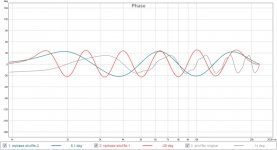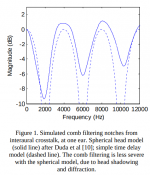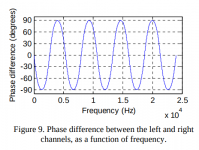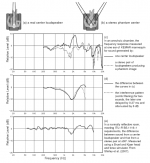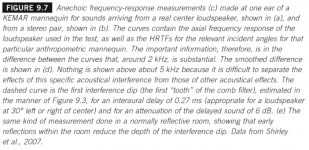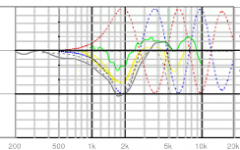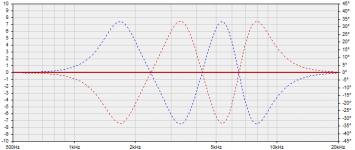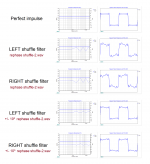Thanks for doing those BYRTT!
Interesting results from this phase only shuffle. Both combined results, either Left plus Right and Left times Right, look pretty good but it does show an SPL change in the separate Left and Right channels at the first wave front, which smooth's out in less than 1 ms. It is a more visible change than I expected from a +/-30 degree phase swing.
I'm going to have to test it again 🙂.
Interesting results from this phase only shuffle. Both combined results, either Left plus Right and Left times Right, look pretty good but it does show an SPL change in the separate Left and Right channels at the first wave front, which smooth's out in less than 1 ms. It is a more visible change than I expected from a +/-30 degree phase swing.
I'm going to have to test it again 🙂.
Alright, I applied the shuffler offline to 3 very different tracks. Next I copied those tracks and their originals to a new folder and let JRiver analyze them to play each at the same SPL level.
I listened to them without knowing which one would be first or last and just listened. I removed the mid/side EQ section I have after that and tried again.
The shuffler won on all tree tracks. It gets me a more open sound in the center. More than I could achieve with my mid/side processing. I did not notice a shift to the back on the tracks I tried. The parts panned midway between center and either side remained clear and at their position, in other words it didn't pull the imaging apart.
I'll revisit this tomorrow when I have more time. So far it's promising. I experienced none of the drawbacks of the original shuffler posted at the beginning of this thread.
It seems I have to find a way to either run 2 convolutions or try and integrate both like Barleywater suggested a while ago. Very promising! Once again I enjoyed the experiment. (by the way I kept the slight EQ boost at ~400 Hz to the sides, cheating, I know)
I do hope more people join in on this thread. 🙂
Talking about Rephase Shuffle 2 by the way. The first time I tested this I only tried the first rephrase based shuffler.
I listened to them without knowing which one would be first or last and just listened. I removed the mid/side EQ section I have after that and tried again.
The shuffler won on all tree tracks. It gets me a more open sound in the center. More than I could achieve with my mid/side processing. I did not notice a shift to the back on the tracks I tried. The parts panned midway between center and either side remained clear and at their position, in other words it didn't pull the imaging apart.
I'll revisit this tomorrow when I have more time. So far it's promising. I experienced none of the drawbacks of the original shuffler posted at the beginning of this thread.
It seems I have to find a way to either run 2 convolutions or try and integrate both like Barleywater suggested a while ago. Very promising! Once again I enjoyed the experiment. (by the way I kept the slight EQ boost at ~400 Hz to the sides, cheating, I know)
I do hope more people join in on this thread. 🙂
Talking about Rephase Shuffle 2 by the way. The first time I tested this I only tried the first rephrase based shuffler.
Last edited:
You mean the one Pano posted?The shuffler won on all tree tracks.
You can use SoX to convolve your two FIR together.It seems I have to find a way to either run 2 convolutions or try and integrate both like Barleywater suggested a while ago.
I will try to include such a feature in the next release of rephase, in a "tool" menu, together with similar useful functionalities (two FIRs to one stereo FIR, etc.)
You mean the one Pano posted?
You can use SoX to convolve your two FIR together.
I will try to include such a feature in the next release of rephase, in a "tool" menu, together with similar useful functionalities (two FIRs to one stereo FIR, etc.)
Yes, the same one BYRTT recreated. Pano posted a course (RePhase Shuffle-2) and a more fine toothed (Rephase Shuffle-1) shuffler.
The Rephase Shuffle-2.wav has very similar phase behavior to the original shuffler, without the FR changes. The other RePhase based shuffler has more fine variations. Edit: Hmmm, might want to review the above statement, here are the 3 phase results of the different shufflers:
Good to know I can combine FIR filters with Sox. Barleywater suggested the same earlier in this thread. I'll look into it tomorrow.
Including this as a tool in RePhase is a wonderful idea. As well as including the shuffler as an option in your marvelous RePhase tool.
Attachments
Last edited:
How to combine convolution IR (and other effects)
The more people who have success with it, the less it seems that it is specifically related to individual head shape, which is good news!
As for combining convolutions, EQ filters etc into a single file, chain together all the plugins (in Reaper) and use separate instances of ReaVerb for convolution. Then run a sweep through this chain and deconvolve to create an IR which captures the entire chain.
Impulse response deconvolution tool software - Voxengo Deconvolver - Voxengo
It gets me a more open sound in the center. More than I could achieve with my mid/side processing. I did not notice a shift to the back on the tracks I tried. The parts panned midway between center and either side remained clear and at their position, in other words it didn't pull the imaging apart.
...
I experienced none of the drawbacks of the original shuffler posted at the beginning of this thread.
...
Talking about Rephase Shuffle 2 by the way.
The more people who have success with it, the less it seems that it is specifically related to individual head shape, which is good news!
As for combining convolutions, EQ filters etc into a single file, chain together all the plugins (in Reaper) and use separate instances of ReaVerb for convolution. Then run a sweep through this chain and deconvolve to create an IR which captures the entire chain.
Impulse response deconvolution tool software - Voxengo Deconvolver - Voxengo
Last edited:
Good morning all! Nice work. Thanks for listening and thanks Brytt for the very informative graphs. 

Pos. Yes, you have full permission to use the shuffler in rePhase if you think it would be handy. Would it be a stand alone, or something that is added to other corrections?
I'm sure this shuffler could be made better. My simple work in rePhase seems to already be a big improvement over the original pseudo-echo shuffler.


Pos. Yes, you have full permission to use the shuffler in rePhase if you think it would be handy. Would it be a stand alone, or something that is added to other corrections?
I'm sure this shuffler could be made better. My simple work in rePhase seems to already be a big improvement over the original pseudo-echo shuffler.
Hi Pano,
I wonder still at the following quote:
"The phase alternations were made to mimic the phase of the original multi-tap shuffler."
There are a few useful clues given in the form of images in the PDF, attached. I am going to make a few more versions based on these images.
Specifically, the first image suggests the frequencies that aught to be phase-decorrelated between L and R.
I wonder still at the following quote:
"The phase alternations were made to mimic the phase of the original multi-tap shuffler."
There are a few useful clues given in the form of images in the PDF, attached. I am going to make a few more versions based on these images.
Specifically, the first image suggests the frequencies that aught to be phase-decorrelated between L and R.
Attachments
Last edited:
Would it be a stand alone, or something that is added to other corrections?
It will be implemented as two presets, "Pano Phase Shuffler - Left" and "Pano Phase Shuffler - Right", in the paragraphic phase EQ tab. That way it will be easy to add it over any existing correction (including individual drivers).
I don't intent to release rephase 1.1 just yet, so there is time for tuning 😀I'm sure this shuffler could be made better.
Data from Floyd Toole's book related to phantom center dip
Toole seems primarily concerned with the ~1.7kHz dip:
"...above about 5kHz... it is difficult to separate the effects of this specific acoustical interference from those of other acoustical effects"
Also of interest is the last graph which shows the comb filtering still has effects in a normal reflective room.
Screenshots taken from Google Books
Toole seems primarily concerned with the ~1.7kHz dip:
"...above about 5kHz... it is difficult to separate the effects of this specific acoustical interference from those of other acoustical effects"
Also of interest is the last graph which shows the comb filtering still has effects in a normal reflective room.
Screenshots taken from Google Books
Attachments
Combined data for comb filter dips
I combined the data above into a single graph. It's pretty messy but indicates that the rephase-2 shuffler could be improved by moving the phase shifts around to better match the measured interference dips, which to be fair are not in complete agreement from one simulation / measurement to another. From looking at the combined graph, deviations occur mainly at:
1.7kHz (similar to rephase-2 shuffler)
3.4kHz
5.5kHz
7.5kHz
10.5kHz
Not sure why these aren't multiples of the first dip.
The actual frequencies of the dips would be individual, related to the spacing of your ears. This data is for the KEMAR head, which as far as I can tell has a radius of 8.75cm, or width of 17.5cm. If anyone can find the actual width of KEMAR that would be helpful. This is extremely close to the width of my own head. I suppose the frequencies should be scaled based on head width.
I combined the data above into a single graph. It's pretty messy but indicates that the rephase-2 shuffler could be improved by moving the phase shifts around to better match the measured interference dips, which to be fair are not in complete agreement from one simulation / measurement to another. From looking at the combined graph, deviations occur mainly at:
1.7kHz (similar to rephase-2 shuffler)
3.4kHz
5.5kHz
7.5kHz
10.5kHz
Not sure why these aren't multiples of the first dip.
The actual frequencies of the dips would be individual, related to the spacing of your ears. This data is for the KEMAR head, which as far as I can tell has a radius of 8.75cm, or width of 17.5cm. If anyone can find the actual width of KEMAR that would be helpful. This is extremely close to the width of my own head. I suppose the frequencies should be scaled based on head width.
Attachments
Last edited:
What are you suggesting, Mike? Adjust all phase deviations to the peak/dip points? Or maximum phase deviation at the peaks and a node (crossing) at the dips... making it a bit more course than using all points as a reference.
The original shuffler almost follows your pattern. Might be worth a shot in RePhase.
The original shuffler almost follows your pattern. Might be worth a shot in RePhase.
I'm listening to it now. Not sure what I think.
https://www.dropbox.com/s/velrupe7ivvpzn3/rephase3-24-44100.wav?dl=1
https://www.dropbox.com/s/velrupe7ivvpzn3/rephase3-24-44100.wav?dl=1
Attachments
You didn't go for the 10.5 KHz point?
Haha, I guess I forgot about it! Since have made another one. Only 1.8kHz, +- 30 degrees. I think I prefer it. Not happy with the last one. Inferior to rephase2. This one has a lot less issues.
Is +-30 degrees optimal? More experimenting is needed.
https://www.dropbox.com/s/bfcs3kqmuk575k6/rephaseMin-24-44100.wav?dl=1
Attachments
And another. 1800 and 5400 only. This one works well, I could tell right away. I like this method of adding a single phase shift at a time, making it possible to hear the effect of each.
https://www.dropbox.com/s/lyuymy2965mrw5j/rephaseMin2-24-44100.wav?dl=1
Note that these are even multiples, which makes a lot more sense...
https://www.dropbox.com/s/lyuymy2965mrw5j/rephaseMin2-24-44100.wav?dl=1
Note that these are even multiples, which makes a lot more sense...
Attachments
Last one for today
Now with 3 bands - 1800,3600,5400
https://www.dropbox.com/s/pr4oymwp0201b4m/rephaseMin3-24-44100.wav?dl=1
This 3rd one sounds quite different from the other 2 which only operate on "odd" (1st and 3rd) comb frequencies. This one pulls the image upward, and brightens it (which I imagine are related effects). Sounds unnatural to me.
Min2 (1800,5400) is the best so far.
I will make a few more then post them all as a zip (1800,3600,5400,7200 - 1800,5400,10800 - all freqs). I kind of doubt that the high frequencies will make a huge (or a positive) difference because they would be so sensitive to head movement.
Now with 3 bands - 1800,3600,5400
https://www.dropbox.com/s/pr4oymwp0201b4m/rephaseMin3-24-44100.wav?dl=1
This 3rd one sounds quite different from the other 2 which only operate on "odd" (1st and 3rd) comb frequencies. This one pulls the image upward, and brightens it (which I imagine are related effects). Sounds unnatural to me.
Min2 (1800,5400) is the best so far.
I will make a few more then post them all as a zip (1800,3600,5400,7200 - 1800,5400,10800 - all freqs). I kind of doubt that the high frequencies will make a huge (or a positive) difference because they would be so sensitive to head movement.
Attachments
Finally struck gold!
OK I've got something really good now.
The premise was to use the minimum amount of +- phase filters, corresponding to the dips shown in the combination graph I posted earlier. The peaks in the measurements should *not* be dealt with in this manner (I created several bad sounding filters which showed this to be the case). The peaks are not related to comb filtering, more on this later.
Min: 1.8kHz (+-30 deg)
Min2: 1.8kHz and 5.4kHz (+-30 deg)
Min6: 1.8kHz, 5.4kHz and 10.8kHz (+-35 deg)
Min6b: (shown) same as above, but Q adjusted to match measurements (+-45 deg)
Min6c: same as above, but +-30 deg
Min7: 1.8kHz, 5.4kHz and 9kHz (+-35 deg)
- Min7 "made sense" as it was +3.6kHz each time, but doesn't work as well as Min6
Min6b is the best so far, hence the bold.
The difference between 6b and 6c is only the amplitude of the phase adjustment. The amount that the dips are filled in sounds proportional to the amount of phase difference between the channels. I haven't pushed it past +-45 yet - imagine this would make things worse.
Further improvement *could* be made by:
- further shaping the curves to better match the measured dips
- matching the amount of phase difference to the severity of each dip (ie. 45@1.8kHz, 37.5@5.4kHz, 30@10.8kHz) ??
- EQ'ing the mid channel down between 2kHz and 10kHz to compensate for peak (difference between HRTF at head-on and where the speakers are actually positioned)
I'd like to hear what you think, especially if you've already tried Pano's rephase-2 IR.
At some point I'll make some WAV samples for those of you who can't easily audition impulse response. It's important to be able to toggle quickly between the filters, so a webapp that has the toggle buttons built in would be best.
OK I've got something really good now.
An externally hosted image should be here but it was not working when we last tested it.
The premise was to use the minimum amount of +- phase filters, corresponding to the dips shown in the combination graph I posted earlier. The peaks in the measurements should *not* be dealt with in this manner (I created several bad sounding filters which showed this to be the case). The peaks are not related to comb filtering, more on this later.
Min: 1.8kHz (+-30 deg)
Min2: 1.8kHz and 5.4kHz (+-30 deg)
Min6: 1.8kHz, 5.4kHz and 10.8kHz (+-35 deg)
Min6b: (shown) same as above, but Q adjusted to match measurements (+-45 deg)
Min6c: same as above, but +-30 deg
Min7: 1.8kHz, 5.4kHz and 9kHz (+-35 deg)
- Min7 "made sense" as it was +3.6kHz each time, but doesn't work as well as Min6
Min6b is the best so far, hence the bold.
The difference between 6b and 6c is only the amplitude of the phase adjustment. The amount that the dips are filled in sounds proportional to the amount of phase difference between the channels. I haven't pushed it past +-45 yet - imagine this would make things worse.
Further improvement *could* be made by:
- further shaping the curves to better match the measured dips
- matching the amount of phase difference to the severity of each dip (ie. 45@1.8kHz, 37.5@5.4kHz, 30@10.8kHz) ??
- EQ'ing the mid channel down between 2kHz and 10kHz to compensate for peak (difference between HRTF at head-on and where the speakers are actually positioned)
I'd like to hear what you think, especially if you've already tried Pano's rephase-2 IR.
At some point I'll make some WAV samples for those of you who can't easily audition impulse response. It's important to be able to toggle quickly between the filters, so a webapp that has the toggle buttons built in would be best.
Attachments
Nice work dynomike, at present haven't a good setup to check sound of your filters.
Can't stop thinking about if a clever less phase turn filter can do the job, reason is for systems that has been braught to fine specs being linear phase as wesayso's system, then the less phase turn would help listening positions that is not at sweet spot so that filter is less destructive at those positions. Below show Pano's "rephrase shuffle-2.wav" benchmarked verse perfect impulse and a alternative one where phase turn only +/- 10º.
Can't stop thinking about if a clever less phase turn filter can do the job, reason is for systems that has been braught to fine specs being linear phase as wesayso's system, then the less phase turn would help listening positions that is not at sweet spot so that filter is less destructive at those positions. Below show Pano's "rephrase shuffle-2.wav" benchmarked verse perfect impulse and a alternative one where phase turn only +/- 10º.
Attachments
Thanks Mike for the further experimentation. I was trying to remember why I chose what I did, and think it was just trying to get the same number of phase rotations into the same bandwidth as the original- with 1.7-2K targeted as the first major shift.
My guess is that the phase shifts should be targeted at the comb filtering caused by an average size head listening to speakers with a standard offset angle. From there, things could be fine tuned to suite the listener and the system.
My guess is that the phase shifts should be targeted at the comb filtering caused by an average size head listening to speakers with a standard offset angle. From there, things could be fine tuned to suite the listener and the system.
OK I've got something really good now.
An externally hosted image should be here but it was not working when we last tested it.
The premise was to use the minimum amount of +- phase filters, corresponding to the dips shown in the combination graph I posted earlier. The peaks in the measurements should *not* be dealt with in this manner (I created several bad sounding filters which showed this to be the case). The peaks are not related to comb filtering, more on this later.
Min: 1.8kHz (+-30 deg)
Min2: 1.8kHz and 5.4kHz (+-30 deg)
Min6: 1.8kHz, 5.4kHz and 10.8kHz (+-35 deg)
Min6b: (shown) same as above, but Q adjusted to match measurements (+-45 deg)
Min6c: same as above, but +-30 deg
Min7: 1.8kHz, 5.4kHz and 9kHz (+-35 deg)
- Min7 "made sense" as it was +3.6kHz each time, but doesn't work as well as Min6
Min6b is the best so far, hence the bold.
The difference between 6b and 6c is only the amplitude of the phase adjustment. The amount that the dips are filled in sounds proportional to the amount of phase difference between the channels. I haven't pushed it past +-45 yet - imagine this would make things worse.
Further improvement *could* be made by:
- further shaping the curves to better match the measured dips
- matching the amount of phase difference to the severity of each dip (ie. 45@1.8kHz, 37.5@5.4kHz, 30@10.8kHz) ??
- EQ'ing the mid channel down between 2kHz and 10kHz to compensate for peak (difference between HRTF at head-on and where the speakers are actually positioned)
I'd like to hear what you think, especially if you've already tried Pano's rephase-2 IR.
At some point I'll make some WAV samples for those of you who can't easily audition impulse response. It's important to be able to toggle quickly between the filters, so a webapp that has the toggle buttons built in would be best.
Interesting! As I have EQ-cuts at ~3.7 and ~7.3 KHz in my mid channel based on earlier cross talk compensation experiments... Your shuffle is almost completely in line with those cuts now with filling in dips at 1.8, 5.4 and 10.8.
I'd like to hear your reasoning about 3.6 and 7.2 KHz.
Nice work dynomike, at present haven't a good setup to check sound of your filters.
Can't stop thinking about if a clever less phase turn filter can do the job, reason is for systems that has been braught to fine specs being linear phase as wesayso's system, then the less phase turn would help listening positions that is not at sweet spot so that filter is less destructive at those positions. Below show Pano's "rephrase shuffle-2.wav" benchmarked verse perfect impulse and a alternative one where phase turn only +/- 10º.
I agree BYRTT, that did cross my mind as well. But Pano's shuffler did work better than just a straight mid/side EQ. At that time, after trying the original shuffler my mind went exactly as yours, rationalizing the time behavior. That's why I initially moved on as I had a pleasing solution.
But the listening test yesterday convinced me there's something to be had here. It would be good to know what the threshold is for it to be effective. Choosing to swing the phase as little as possible 🙂.
Thanks Mike for the further experimentation. I was trying to remember why I chose what I did, and think it was just trying to get the same number of phase rotations into the same bandwidth as the original- with 1.7-2K targeted as the first major shift.
My guess is that the phase shifts should be targeted at the comb filtering caused by an average size head listening to speakers with a standard offset angle. From there, things could be fine tuned to suite the listener and the system.
Thanks for starting this thread, and I agree, individual fine tuning might even bring a greater revenue. This is starting to look like a combined solution for a couple of stereo problems.
Last edited:
- Home
- Loudspeakers
- Multi-Way
- Fixing the Stereo Phantom Center
